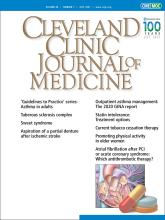Article Figures & Data
Tables
How many cigarettes do you smoke a day? Score 10 or fewer 0 11–20 1 21–30 2 31 or more 3 How soon after waking up do you smoke your first cigarette of the day? Score 60 minutes 0 31–60 minutes 1 6–30 minutes 2 Within 5 minutes 3 Level of nicotine dependence by total score: 0–2 = low 3–4 = moderate 5–6 = high Based on information in reference 4.
Brief advice: “Quitting is the best way to improve your health.” Develop discrepancy: “How do you think your smoking is affecting your loved ones?” Express empathy: “Many people worry about managing without cigarettes.” Manage resistance: “You are worried about how you would manage withdrawal symptoms.” Personalized messages: “The best way to prevent lung cancer is to quit smoking.” “The best way to prevent another heart attack is to quit smoking.” Connect to resources: “There are many effective options. I can help you find the best effective treatment for you.” Support self-efficacy: “Would you like information about the benefits and strategies of quitting?” Drug, available doses Dosing Administrationa Common side effects Comments Nicotine patch (7 mg, 14 mg, 21 mg) ≤ 10 cigarettes/day: start with nicotine patch 14 mg/day
> 10 cigarettes/day: start with nicotine patch 21 mg/dayApply one patch each morning to any non-hairy, clean, dry skin on upper body or outer arm. Rotate the site daily to avoid skin irritation.
After 6 weeks, taper to lower doses for 2-4 weeks.Skin irritation Insomnia Vivid dreams Consider removing patch at bedtime in case of insomnia and vivid dreams. Nicotine gum (2 mg, 4 mg) Smokers wait > 30 min after waking to smoke: use 2 mg
Smokers smoke within 30 min of waking: use 4 mg"Chew and park" is recommended: chew until tingling sensations occurs, then "park" until tingling disappears. Then chew again to repeat.
Chew one piece of gum every 1-2 hours or whenever there is an urge to smoke.
Use up to 24 pieces of gum/day per day for 6 weeks.
Gradually reduce use over a second 6 weeks, for a total duration of 3 months.Mouth irritation
Esophageal and gastric irritation
Hiccups
Jaw pain
Nausea/vomiting
Excess salivation
Headache
PalpitationsAvoid acidic beverages (eg, coffee, carbonated drinks) 15 minutes before and during gum use, as they reduce nicotine absorption. Nicotine lozenge (2 mg, 4 mg) Smokers wait > 30 min after waking to smoke: use 2 mg
Smokers smoke within 30 min of waking: use 4 mgPlace lozenge in the mouth and allow it to dissolve for 30 minutes.
Use 1 lozenge every 1-2 hours for 6 weeks.
Maximum five lozenges every six hours or 20 lozenges per day.
Gradually reduce number of lozenges used per day over a second 6 weeks.Mouth irritation
Mouth ulcers
Abdominal pain
Hiccups
Nausea/vomiting
Diarrhea
Headache
PalpitationsDo not chew lozenge.
Avoid acidic beverages (eg, coffee, carbonated drinks) 15 minutes before and during gum use, as they reduce nicotine absorption.Nicotine inhaler (10 mg/cartridge) Puff into mouth as needed; use 6-16 cartridges per day (at least 6 cartridges per day for the first 3-6 weeks) for up to 12 weeks Inhale deeply into back of throat or puff in short breaths.
Maximum 16 cartridges per day.
Gradually reduce dose over 6-12 weeksMouth irritation Throat irritation Cough Required frequent use.
Each cartridge lasts about 20 minutes if continuously puffing.
Inhaled nicotine may cause bronchospasm.Nicotine nasal spray (10 mg/mL) Use 1 spray in each nostril 1-2 times per hour Maximum of 10 sprays per hour or 80 spray per day.
Adjust dose as needed based in response.
Gradually reduce dose after 12 weeks.Side effects are common (headache, throat irritation, cough, rhinitis).
Nasal irritation may be a reason to stop.Provides a more rapid rise in plasma nicotine concentration than that produced by agents absorbed via the oral mucosa. Bupropion SR (sustained release) (150 mg) 150 mg once daily for 3 days, then increase to 150 mg twice daily Begin at least 1-2 weeks before target quit date.
May use longer than 12 weeks if needed for maintenance.
Consider combination therapy, discontinuation, or alternative agent if no progress is made by seventh week.Insomnia
Headache
Dizziness
Diaphoresis
Weight loss
Xerostomia
Nausea/vomitingConsider lowering dose to 150 mg daily if full dose not tolerated.
Decreases seizure threshold.Varenicline (0.5 mg, 1 mg) Days 1-3: 0.5mg once daily
Days 4-7: 0.5 mg twice daily
Day 8 and later: 1 mg twice dailyTreatment should be continued for 12 weeks but can be extended.
Consider dose reduction if usual dose is not tolerated.Insomnia
Nausea/vomiting
Abnormal dreams
Headache
Nasopharyngitis
XerostomiaVarenicline does not increase the risk of depression, suicidal ideation, or cardiovascular disease. ↵a Nicotine replacement therapy is recommended for 2 to 3 months after smoking cessation. However, it may be used through the period when the patient is at high risk for relapse. Some smokers may need to use nicotine replacement products indefinitely.
Agent Potential drug interactions Nicotine replacement therapies Adenosine, cimetidine, varenicline Varenicline Alcohol, nicotine, OCT2 inhibitors (eg, histamine-2-receptor blockers, quinolones, tafenoquine, trimethoprim) Bupropion Drugs that lower seizure threshold (eg, alcohol, selective serotonin reuptake inhibitors, tricyclic antidepressants, systemic steroids) CYP2D6 substrates (eg, aripiprazole, atomoxetine, brexpiprazole, clozapine, codeine, duloxetine, fesoterodine, galantamine, hydrocodone, iloperidone, metoprolol, metoclopramide, nebivolol, pimozide, primaquine, selective serotonin reuptake inhibitors, tamoxifen, tamsulosin, thioridazine, tramadol, tricyclic antidepressants, valbenazine, vortioxetine) Dopaminergic medications (eg, amantadine, levodopa) CYP2B6 inducers (eg, carbamazepine, efavirenz, nelfinavir, nevirapine, phenobarbital, phenytoin, primidone, rifampin, ritonavir) CYP2B6 inhibitors (eg, clopidogrel, mifepristone; ticlopidine) Digoxin, monoamine oxidase inhibitors Cigarette smoke CYP1A2 substrates (eg, clozapine, fluvoxamine, olanzapine, tacrine, theophylline) OCT2 = organic cation transporter 2
Based on information in references 24, 43, and 49.






